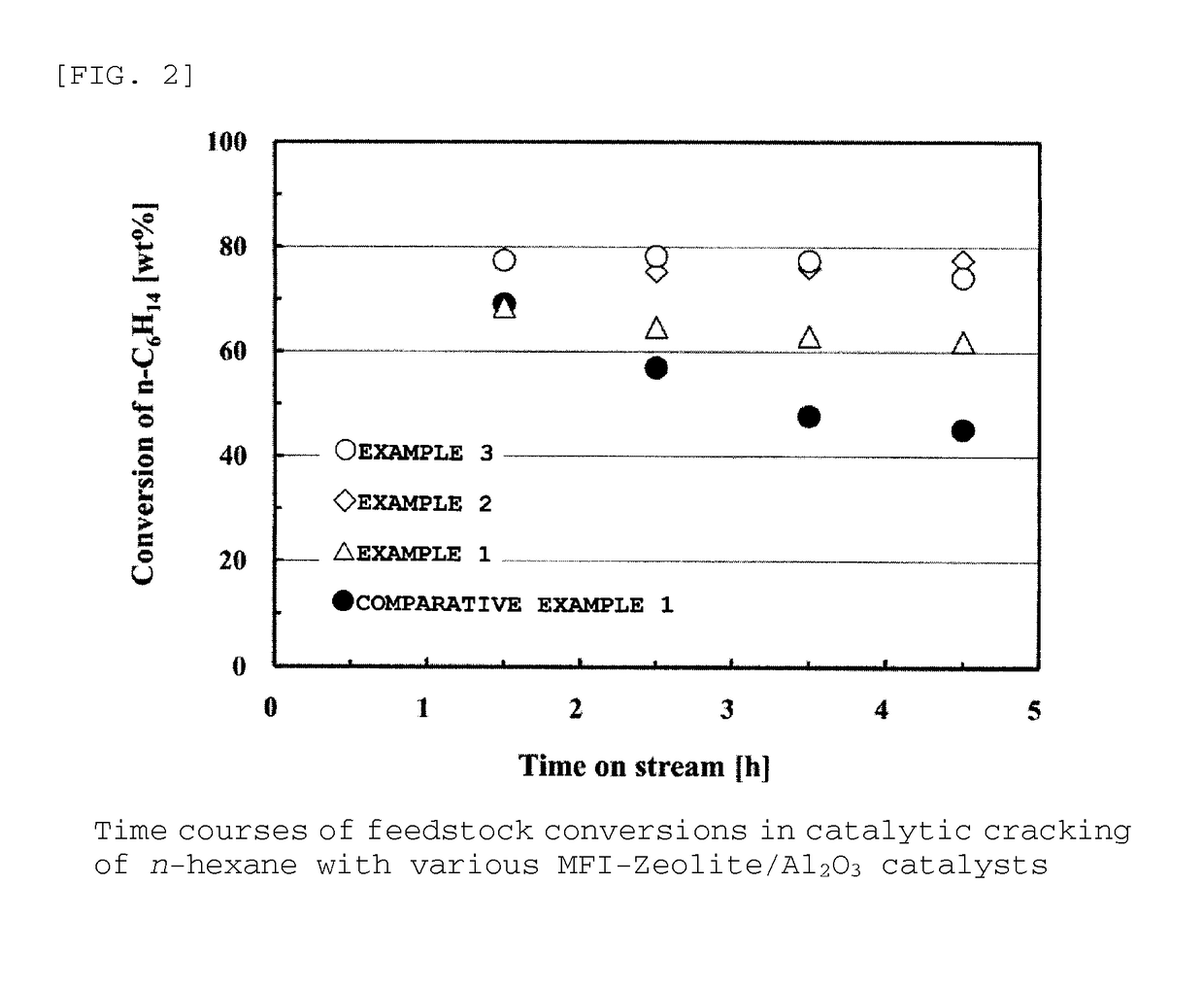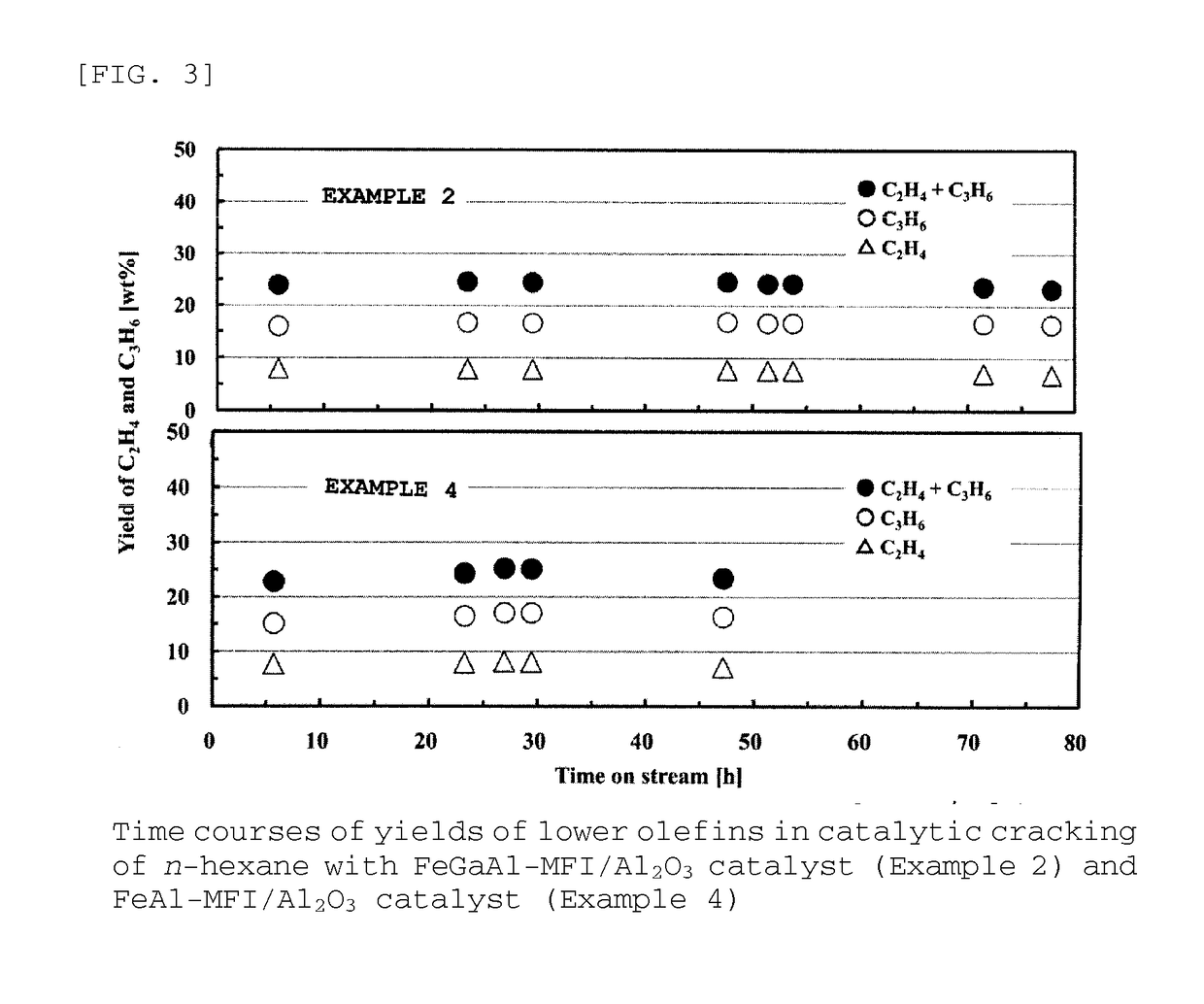Zeolite catalysts, methods for producing zeolite catalysts, and methods for producing lower olefins
a technology of zeolite catalyst and catalyst, which is applied in the field of zeolite catalyst, can solve the problems of large amount of energy consumption and insufficient propylene supply by this technique, and achieve the effects of suppressing increasing the formation of aromatic hydrocarbons, and reducing acid strength
- Summary
- Abstract
- Description
- Claims
- Application Information
AI Technical Summary
Benefits of technology
Problems solved by technology
Method used
Image
Examples
example 5
[0155]Next, it is described below how to prepare a FeGaAl-MFI zeolite (Si / (Fe+Ga+Al)=31.3) / alumina composite.
[0156]Na-type FeAl-MFI zeolite was synthesized in the same manner as in Example 1, except that a solution composed of 58.9 g of colloidal silica (30.6 wt % of SiO2, 0.4 wt % of Na2O, and 69.0 wt % of H2O) and 2.25 g of sodium hydroxide was used instead as the liquid A and that a solution composed of 0.76 g of aluminum sulfate n-hydrate, 0.44 g of gallium nitrate n-hydrate, 0.98 g of iron nitrate 9-hydrate, 4.65 g of tetrapropylamrnonium bromide, and 187.2 g of water was used instead as the liquid B.
[0157]In addition, the resultant powdery Na-type FeGaAl-MFI zeolite and alumina powder were used and molded in the same way as in Example 4, so that a cylindrical FeGaAl-MFI zeolite / alumina composite was obtained.
[0158]The composite was then subjected to ion-exchange to prepare a FeGaAl-MFI zeolite / alumina composite catalyst. The ion-exchange was performed in the same way as in Exa...
example 6
[0161]It is described below how to prepare a FeGaAl-MFI zeolite (Si / (Fe+Ga+Al)=12.0) / alumina composite in Example 6.
[0162]Na-type FeAl-MFI zeolite was synthesized in the same manner as in Example 1, except that a solution composed of 58.9 g of colloidal silica (30.6 wt % of SiO2, 0.4 wt % of Na2O, and 69.0 wt % of H2O) and 3.98 g of sodium hydroxide was used instead as the liquid A and that a solution composed of 2.54 g of aluminum sulfate n-hydrate, 1.46 g of gallium nitrate n-hydrate, 3.26 g of iron nitrate 9-hydrate, 15.49 g of tetrapropylammonium bromide, and 185.1 g of water was used instead as the liquid B.
[0163]In addition, the resultant powdery Na-type FeGaAl-MFI zeolite and alumina powder were used and molded in the same way as in Example 4, so that a cylindrical FeGaAl-MFI zeolite / alumina composite was obtained. The composite was then subjected to ion-exchange to prepare a FeGaAl-MFI zeolite / alumina composite catalyst.
[0164]The ion-exchange was performed in the same way as...
example 1
[0230]It is described below how to synthesize FeGaAl-MFI zeolite (Si / (Fe+Ga+Al)=92.9 (acid density)) in Example 1.
[0231]Liquids A and B were prepared, in which the liquid A was a solution composed of 58.9 g of colloidal silica (30.6 wt % of SiO2, 0.4 wt % of Na2O, and 69.0 wt % of H2O) and 1.76 g of sodium hydroxide, and the liquid B was a solution composed of 0.25 g of aluminum sulfate n-hydrate, 0.15 g of gallium nitrate n-hydrate, 0.33 g of iron nitrate 9-hydrate, 4.13 g of tetrapropylammonium bromide, and 187.8 g of purified water. The liquids A and B were gradually mixed by stirring at room temperature, and the mixture was then further vigorously stirred for 15 minutes in a mixer.
[0232]The mixture solution was allowed to stand overnight while its temperature was kept at 60° C. Subsequently, the mixture solution was subjected to a hydrothermal synthesis reaction at its own pressure in an autoclave under the conditions of 150° C., 72 hours, and 300 rpm.
[0233]After cooled, the pro...
PUM
| Property | Measurement | Unit |
|---|---|---|
| boiling points | aaaaa | aaaaa |
| boiling points | aaaaa | aaaaa |
| sizes | aaaaa | aaaaa |
Abstract
Description
Claims
Application Information
 Login to View More
Login to View More - R&D
- Intellectual Property
- Life Sciences
- Materials
- Tech Scout
- Unparalleled Data Quality
- Higher Quality Content
- 60% Fewer Hallucinations
Browse by: Latest US Patents, China's latest patents, Technical Efficacy Thesaurus, Application Domain, Technology Topic, Popular Technical Reports.
© 2025 PatSnap. All rights reserved.Legal|Privacy policy|Modern Slavery Act Transparency Statement|Sitemap|About US| Contact US: help@patsnap.com



